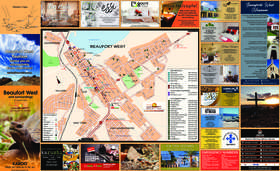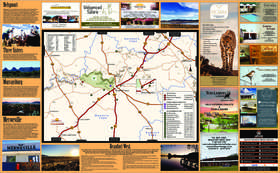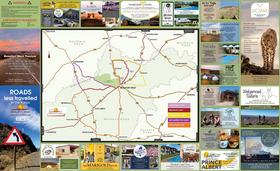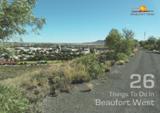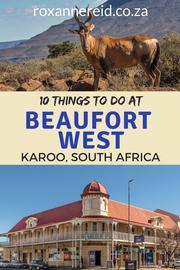Rock Engravings
The rock art site at Nelspoort covers a vast area and features hundreds of engravings. These were done by Bushmen (hunter-gatherer people also known as ‘/Xam’) and Khoe herders (also known as ‘Khoi-khoi’ and previously as ‘Hotttentots’) and settlers or even more modern people, as there is a certain amount of graffitti on the rocks of the area.
Nelspoort was once a farm known as Klipkraal. Nelspoort town is surrounded by dolerite koppies (between 1 000 and 1 400 m high) which form a poort or ravine through which the Sout River flows. These koppies are quite significant in an otherwise predominantly flat region.
The presence of water and varied biomes made this a favoured home for southern Africa’s First People – the Bushmen, and later Khoe herders and White farmers settled here. Each of these cultures has left their mark on the landscape but the most striking of these is the rock engravings, a legacy of the Bushmen.
At least three different rock engraving traditions are present:
- Bushman
- Khoe
- Historic Period
Among the latter is a Swedish poem on rocks on a neighbouring farm.
At present every effort is being made to ensure that the site is not damaged in any way. Tourists are only allowed to visit by appointment and with a guide.
A custodian has been appointed for this site. He is the Restvale Primary School Head, Mr. Laurence Rathenham, and his contact details are as follows
PO Box 350, Beaufort West, 6970
Telephone and Fax 023-4161648
head@restvale.wcape.school.gov.za
Details are also obtainable from the Central Karoo Regional Tourism Office:
Private Bag X560, Beaufort West, 6970, Tel. 023-4151160, Fax 023-4143675
The sites in detail
Rock engravings can be found in 11 different sites:
- Site 1 - The Rock Gong Complex
- Site 2 - The Koekoen Geometric Site
- Site 3 - Elephant and Rhino Rock Art
- Site 4 - The Big Elephant Site
- Site 5 - The Big Eland
- Site 6 - A "Bit of Everything" Site
- Site 7 - Bird, Geometric and Gong Rock Site
- Site 8 - Spoor and Being
- Site 9 - Extinct Buffalo Site
- Site 10 - Kloof site
- Site 11 - Flat Eland
Site 1 - The Rock Gong Complex
This site, known as Klipkraal 1, is located 80 m west of the tar road leading into Nelspoort from the north. It is a Later Stone Age site and covers a period dating back 30 000 years and ending at about 1850. There is a Bushman campsite on the northern slope of the ridge. This is indicated by stones which have been arranged in a rough circle. Within and around this circle as well as scattered throughout the ridge there are many general purpose stone tools which were used for cutting, scraping and so forth. This abundance of tools, a few ostrich shell shards and some grind stones indicate that the site was a favoured home for Bushmen hunter-gatherers and later Khoekhoen herder peoples.
About a dozen engravings in this area can confidently be called ‘Bushman’. These are animal and human figures that have been pecked into the rock. There are also some engravings which have been incised into the rock with a sharp stone or perhaps even a metal object that the Bushmen would have obtained by trade with Bantu-speaking farmers, Khoe herders or White settlers.
Klipkraal 1 is notable for the large number of ‘gong rocks’ encountered there.
‘Gong rocks’ are naturally-occurring dolerite (also known as ‘ironstone’) boulders that either rest on top of other such boulders or have a natural crack through them that acts as a natural resonator. Some of these boulders show signs of having been hammered by people with stones to produce a metallic-sounding noise. These gong rocks are often associated with Bushman rock engravings and current research indicates that sound was a very important part of rock ‘art’ sites. In the same way music and architecture were vital to Christian cathedrals, so the eerie, elemental sound of the gong rocks would have travelled over the landscape, imbuing the rock engraving site with a particular level of extra-ordinariness.
Geometric Khoe herder rock engravings have also been found at this site. These include circles, sunburst-like motifs, grids and so forth. The Khoe would have been attracted to this area as there was sufficient water, from the Kambro and Sout Rivers, for their stock and for initiation ceremonies.
There are some Historic Period rock engravings or more modern 'graffiti' that have historical value as they chronicle the arrival and occupation of this landscape by White settlers, as well as latter-day KhoeSan, groups such as the Nama. There are also more recent animal engravings made in an incised technique. These were made by non-Bushmen.
The site is in a good condition, but there are isolated instances of vandalism.
Site 2 - The Koekoen Geometric Site
Klipkraal 2 is located immediately to the south-east of Site 1 and is right next to the tar road. We have no idea how big this site was, as much of it was destroyed when the tar road was constructed. During this road building a number of engraved rocks were also moved from their original positions.
There are fewer stone tools at this site, but there are many ground and scratched patches on the rock surfaces. This suggests that a great deal of grinding of plant foods, ochre and other materials took place here. There are also very few Bushman rock engravings at this site. The ones that are present include deeply patinated animals, mostly eland.
Khoe herder rock engravings dominate this site. There are over 60 examples and these cover a great range of forms – rectangular, circular, zigzag, shield and egg-like designs. There are also some Historic Period engravings (graffitti). Most of these are rudimentary animal images. Slightly further up the hill are small scraped circles arranged in a horseshoe shape, joined together by smaller circles. They appear to be an aerial view of a kraal and it is not known who made this design.
Site 3 - Elephant and Rhino Rock Art
Klipkraal 3 is an isolated rock located among a small cluster of boulders at an elevation of 1 000 m overlooking the southern entrance to the settlement. Very few stone tools were found here and only two grinding patches were observed.
The site has three dominant Bushman rock engravings. The images, which are very detailed, show a black rhino, an elephant and an eland. This site also has an incised and scraped horse with small rider (thought to date back to the Anglo-Boer War) and a number of other similar figures. These are considered Historic Period engravings as the rock is covered with cut and scrape marks.
Site 4 - The Big Elephant Site
Klipkraal 4 is located at an elevation of 1 100 m on the far (western) side of the first hill immediately west of Site 3. At this site there is a single, 1.2 m long incised and scraped elephant with erect penis, tusks, trunk with nasal emission, large ears and feet depicted as though they were spoor (tracks). There are two deep incisions, a few rubbed patches and a miscellany of scratches and scrapes visible on the rock.
Site 5 - The Big Eland
Klipkraal 5 is located at the top and western-most point at an elevation of 1 080 m. It overlooks Site 2. Few stone tools are present at this site, but grinding patches are abundant. The ground immediately in front of the very large engraved eland looks as though it has been hollowed out.
More than 14 engraved rocks with eland, antelope and ostrich in a light incised & scraped technique have been found at this site. All display a medium degree of patination. On the vertical side of the largest boulder there is a 900 mm x 450 mm square and fat-looking eland, surrounded by a smaller eland and a human figure that may be hunting the large eland. On the opposite side of the boulder there are engravings of ostriches. The rock with the large eland is covered with names, dates and recent and old scratches. There is a thrice-repeated ‘hangman’ motif and names and dates extending back to the 1840s.
There are also a handful of geometric Khoekhoen engravings at this site. One depicts a bag, apron or stretched out animal skin with pecked outline and fine incised interior that may represent a Khoekhoen initiation item. This engraving is deeply patinated which indicates it is very old.
Site 6 - A "Bit of Everything" Site
Klipkraal 6 is located 80 m to the west of Site 5 at the same elevation on the western edge of the mountain plateau overlooking a seasonal river course that feeds into the Kambro River 700 m to the north. The ‘site’ sprawls over at least 75 m. It has a light scatter of stone tools and about a dozen grinding patches.
There are at least 16 engraved rocks showing an interesting a number of engraving techniques including incised, scraped, pecked outlines and an unusual almost bas-relief technique. This has a broad pecked and partial outline that emphasises the body of the animal’s unengraved interior. Eland are dominant. As at Site 5, one very large boulder’s vertical side bears imagery of a large eland accompanied by ostrich, other antelope and a rare depiction of a feline. The bas-relief engraving looks like a hartbeest or blesbok. There is also a large and a fine scraped eland. There are at least three convincing dolerite gong rocks that bear multiple patches of hammering/percussion marks.
The Khoe herder engravings take the form of two adjacent rocks that have a series of extremely fine engraved lines that radiate out from an incised oblong shape like the tassels on a bag. These lines are patinated and only visible in oblique light conditions. Interestingly, very similar motifs occur in the Magaliesberg of Gauteng Province.
The Historic Period engravings, on the eastern edge of this site, consists of a large and central boulder with a stack of predominantly Anglo-Boer War names. These include names like ‘Pte Blake’ and regiment names. These are engraved on top of older Bushman engravings. There is also a ‘volg die pyle’ (‘follow the arrows’) sentence and at least 4 arrows that do not seem to lead to anything.
Site 7 - Bird, Geometric and Gong Rock Site
Klipkraal 7 is located immediately west and on the other side of the seasonal tributary overlooked by Site 6. The site consists of a small dolerite-covered hill that is part of the same ‘spine’ of rock ridge that links Sites 5-7. Site 7 acts as an entrance to the small kloof or ravine that ends at the spring that feeds the seasonal stream. A small road runs right past the small and steep hill. There is a good scatter of quite large stone tools, some of which may belong to the Smithfield Industry, covering the period 5 000 - 12 000 years ago. There are also about ten grinding patches at this site.
There are at least eight engraved rocks here. The two exceptional engravings show two part-human and part-bird figures called ‘avianthropes’. One figure is show in frontal view with wings held out at 90° to its body. Oddly, the feathers of these wings point upwards. The second such figure is a slightly more profile view with longer human legs and shorter wings. These figures are well-patinated; suggesting some antiquity. These engravings are all in the pecked infill technique and exhibit an medium to old degree of patination.
There are two very good gong rocks here and the excellence of their resonance indicates that they may even have been played in harmony.
On the north-eastern side of the hill there are numerous and convoluted circular, joined circular and joined rectangular and square forms, Khoe engravings. There are also some most unusual ‘stitched’ like designs, but almost no Historic Period engravings.
Site 8 - Spoor and Being
Klipkraal 8 is located immediately north (50 m) of the dam wall where the Kambro and Salt Rivers meet on the eastern Bank. The service road, which cuts past this site, probably destroyed several engravings when it was made. The site is located at an elevation of 1 020 m.
There is a large roughly circular stone kraal somewhat oddly placed on a steep part of the lower slopes of the mountain, a light scattering of stone tools and about two dozen grinding patches.
Several dozen rocks at this site are engraved in a variety of techniques. Mostly the drawings are of antelope, ostrich, small buck and eland, but interestingly there is a track of 13 feline pugmarks (spoor); a ‘spiderweb’ sunburst motif and a very odd human figure with long arms and ‘talons’ and a body made up of concentric circles.
Khoe herder engravings include pecked outline and ‘flower-like’ designs; especially somewhat higher up the slope and on the summit. These geometrics have a very loose structure. There is little in the way of Historic Period rock engravings.
Site 9 - Extinct Buffalo Site
Klipkraal 9 consists of a scatter of small boulders widely dispersed around a very large central dolerite boulder on the flat western plateau north-east of Site 8 at an elevation of 1 060 m contour. There are almost no tools and few grinding patches, but there is a roughly circular house foundation and western-style crockery.
There are 20 or more engraved rocks including ostrich, eland and a well executed pecked outline human figure. One rock has an incised equid that has only stripes on the head and hindquarters. It may represent the extinct quagga.
One exceptional engraving at Klipkraal is of a 99 cm long large bovine that may represent the extinct Giant Buffalo, Pelorovis antiquus.
First recorded by noted Northern Cape archaeologist Dr. Gerhard Fock in the 1960s, the Giant buffalo became extinct at some point between 2 000 - 12 000 years ago and this is a rare representation of an extinct animal in Bushman rock art. The grooved lines used to make the outline of this animal are most unusual. Below the buffalo is a similar kudu-like animal. There is also a more recent ostrich and two rubbed patches, a few geometrics and a partially legible sentence in Dutch.
Site 10 - Kloof site
This site is a few hundred metres east of Site 9 on the western side of a kloof in which a small stone-walled settlement has been built, probably by bywoners or even people like the Griqua. The rock art, slightly apart from this settlement, is at an elevation of 1 040 m.
The settlement dates to more recent times and has the remains of knives, crockery, glass, gin bottles and so forth and a midden. There are, however, some stone tools and numerous grinding patches nearby.
There are three main engraved rocks at this site. One features a large-bottomed human figure, possibly female. There is also a male human figure with a ‘V’ shape across his chest. Lower down at the mouth of the kloof is a large boulder with images of an ostrich; a female figure with breasts, large buttocks and raised arms with a much smaller human figure within it – in its stomach area. There is also a pecked infill rhino-like animal with graceful body and raised short tail. There is also a small human figure, bending forward, with an infibulated penis (bar across front of penis). In the nearby kloof there are at least two gong rocks with repeated hammer marks.
Combined with the Bushman engravings on the large rock are Khoekhoen geometrics in the form of three double concentric circles, a wiggly zigzag single line and a wiggly zigzag double line. The patination of both Bushman and Khoekhoen engravings is very similar; suggesting a close time relation.
Engravings from the Historic Period include a western ‘Viking’ looking human figure and names of people who once lived in the vicinity.
Site 11 - Flat Eland
Klipkraal 11 consists of a large flat brown dolerite rock surrounded by a highly dispersed scattering of perhaps a dozen engraved rocks. The site is located at an elevation of 1 180 m on the flat plateau that curves around the small valley that opens out to Nelskop to the east. There is a dispersal of stone tools in the area.
Bushman rock engravings inlcude an eland, ostrich and antelope engraved in incised and scraped techniques. The large flat rock has a panel of half-a-dozen scraped eland and also three bird-like animals along with what may be rudimentary human figures and many scratches. There are no visible Khoe herder engravings. Historic Period engravings include numerous horses, ostriches and even trains. The railway line lies to the south-east and is clearly visible from this site.
Acknowledgements
Grateful thanks to Sven Ouzman of the Department of Anthropology at the University of California at Berkeley for the information on the Rock Art sites at Nelspoort, which formed part of a site report sponsored by the Rock Art Department of the National Museums.
Sven Ouzman
Fulbright Scholar
Anthropology Department, 232 Kroeber Hall
University of California at Berkeley, CA 94720-3710, USA
ouzman@uclink.berkeley.edu
www.ls.berkeley/dept/anth
Associate Editor
Before Farming: the Archaeology and Anthropology of hunter-gatherers
www.waspjournals.com
Member of the Editorial Board
The South African Archaeological Bulletin



